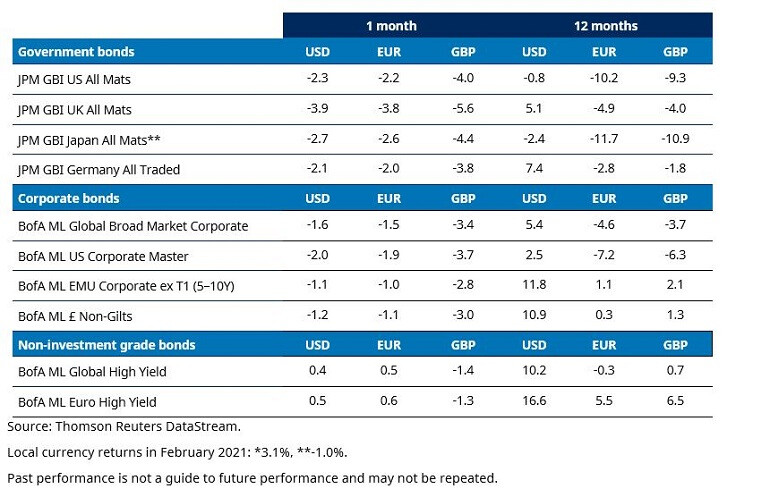Monthly markets review - February 2021
A look back at markets in February when optimism over vaccination programmes helped spur gains for shares and commodities.

Authors
- Global equities gained in February, with lowly-valued parts of the market faring well. Vaccine optimism ultimately trumped fears that a stronger-than-expected economic rebound could alter the trajectory of monetary policy.
- Government bonds saw a sharp sell-off in late February. Corporate bonds outperformed government bonds in the month.
- Commodities gained with energy the best-performing index component as crude oil prices continued to rise.
Please note any past performance mentioned is not a guide to future performance and may not be repeated. The sectors, securities, regions and countries shown are for illustrative purposes only and are not to be considered a recommendation to buy or sell.
US
US equities survived a bout of turbulence to post gains in February. Fears that a rapid economic recovery would hasten policy tightening rattled bond markets before rippling into equities, especially tech. As the fears receded, markets recovered. Sectors that are most sensitive to the economic cycle – such as energy, financials, and industrials - performed strongly. More traditionally defensive sectors, such as utilities and consumer staples, lagged.
Eurozone
Eurozone equities gained in February, supported by a strong advance for lowly-valued parts of the market such as banks. The energy sector also posted robust gains. Defensive sectors such as utilities and real estate were among the laggards. Eurozone annual inflation was confirmed at 0.9% for January and GDP was down by 0.6% in Q4 2020. The Italian parliament approved the formation of a new government to be led by former European Central Bank chairman Mario Draghi.
UK
UK equities also performed well, further reversing some of the underperformance suffered during the global pandemic’s initial stages. The market responded well to progress on vaccinations. Lowly valued and domestically focused areas outperformed.
Japan
Japanese equities rose sharply in early February, before giving up some of the gains. There was some rotation out of growth-style stocks and the market was led by lower quality factors (lower quality stocks tend to have more volatile earnings, weaker balance sheets and lower profit margins). Smaller companies underperformed. The Covid-related state of emergency should be lifted in early March and the vaccine roll-out is underway following the first regulatory approvals, which were granted in mid-February. Recent strong corporate results have led to upward revisions to estimates and increased expectations for a full corporate earnings recovery.
Asia (ex Japan)
Asia ex Japan equities achieved a modest gain in February. Progress on the global roll-out of Covid-19 vaccines, and the prospect of US fiscal stimulus, boosted investor optimism. However, expectations for higher inflation prompted a sell-off towards the end of the month. India was the best-performing index market as the Union Budget announcement boosted sentiment. Hong Kong and Taiwan, where strong performance from IT stocks supported gains, both finished ahead of the index. Conversely, Pakistan was the weakest index market. China also finished in negative territory, amid weakness from internet stocks.
Emerging markets
Emerging market (EM) equities recorded small gains. Early progress was driven by vaccine optimism and expectations for US fiscal stimulus, but were partly offset by concerns over stronger growth and higher inflation. A stronger dollar was also a headwind for EM. Argentina was the best-performing market in the EM index. Chile and Peru, aided by commodity price strength, and Greece, where hopes for a recovery in tourism picked up, all outperformed. Brazil was the weakest index market, negatively impacted by policy concerns. China also finished in negative territory and underperformed the index, with weakness from internet and IT stocks dragging on performance.
Global bonds
In fixed income, government bonds saw a sharp sell-off in late February, with corporate bonds outperforming. Having risen steadily on expectations of substantial US fiscal stimulus, government yields lurched higher late in the month (meaning prices fell), as a US Treasury bond auction saw muted demand. The US 10-year Treasury yield rose 36 basis points (bps) to 1.43%. Italian government bonds outperformed German, as investors welcomed the appointment of Mario Draghi as prime minister. The UK 10-year yield increased by 49bps to 0.82%, reflecting optimism around the UK’s fast vaccine roll-out and plans for easing lockdown.
Corporate bonds outperformed government bonds. Investment grade produced negative total returns amid the global sell-off in yields, but high yield delivered gains. Investment grade bonds are the highest quality bonds as determined by a credit rating agency; high yield bonds are more speculative, with a credit rating below investment grade. Emerging market (EM) bonds declined overall. EM corporate bonds registered a relatively small decline, outperforming EM sovereigns, and EM high yield produced positive returns. EM currencies weakened in the final week of the month as US Treasury yields rose.
The Refinitiv Global Focus index, which measures balanced convertible bonds, advanced 3.1% compared to the MSCI World equity index’s gain of 2.6%. Given the demand for convertibles, valuations rose and the overall asset class is now slightly expensive. At the same time, the weaker technology sector resulted in US convertibles giving up some of their previous high valuations.
Commodities
In commodities, the S&P GSCI posted a robust return as the continued roll-out of Covid-19 vaccinations supported the outlook for a strong recovery in global growth. Energy was the best-performing index component as crude oil prices continued to pick up. The industrial metals component performed well, led by strong gains for copper, often viewed as bellwether for the global economy, and aluminium. The agriculture component achieved a modest gain in the month, boosted by higher coffee, sugar and cotton prices. The livestock component posted a moderate return, with a strong gain for live hogs. By contrast, the precious metals component registered a negative return in the month, with both gold and silver weaker.
The value of investments and the income from them may go down as well as up and investors may not get back the amounts originally invested.


Authors
Topics